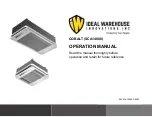
English
13
•
When extending the drain hose, use a commercially available drain extension hose, and be sure to
insulate the extended section of the drain hose which is indoor units.
(Refer to Fig. 18)
•
Make sure the diameter of the piping is the same as the piping (hard vinyl chloride, nominal diameter
13mm) or bigger.
•
When directly connecting a hard vinyl chloride pipe joint (nominal diameter 13mm) to the drain hose
connected to the indoor unit (i.e. for embedded piping, etc.), use a commercially available hard vinyl
chloride pipe joint (nominal diameter 13mm).
(Refer to Fig. 19)
CAUTION
•
Do not bend or twist the drain hose connected to the indoor unit to avoid applying an excessive force.
(Applying an excessive force to the drain hose can cause water leakage.)
•
When installing the separately provided drain up kit, please refer to the installation manual provided with
the drain up kit.
(2) Make sure the drain works properly.
•
After drain piping work is complete, perform a
drain check by opening the front panel,
removing the air filter
, pouring water into
the drain pan, and making sure water flows
smoothly out of the drain hose.
(Refer to Fig. 20)
CAUTION
Drain piping connections
•
Do not connect the drain piping directly to sewage pipes that smell of ammonia. The ammonia in the
sewage might enter the indoor unit through the drain pipes and corrode the heat exchanger.
Indoor unit drain hose
Extension drain piping
(commercially available)
Insulating tube
(commercially available)
Insulating tape (accessory) (3)
( Refer to “5. INDOOR UNIT INSTALLATION” )
Fig. 18
Drain hose connected
to the indoor unit
Commercially available
hard vinyl chloride pipe
joint (nominal diameter 13mm)
Commercially available
hard vinyl chloride pipe
(nominal diameter 13mm)
Fig. 19
Plastic container
for pouring
Drain pan
Make sure not to splash the water.
Fig. 20
3P184443-9J_FM6.book Page 13 Wednesday, December 14, 2011 10:29 AM















































